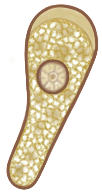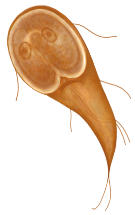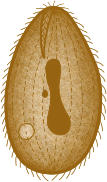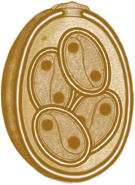Exercise 24. Give the English equivalents of the Russian words in brackets.
1. The fungus is found in (почва, содержащаяптичийпомет). 2.The organism may also enter the body through the mouth, and from there (вызыватьзаражениекишечника).3. Thefungalinfectionmay (оставатьсялокализованной) inthelungs, oritmay (распространятьсячерезкровоток) to the other parts of the body. 4. If the lungs are (первичноеместоположение) of infection, the animal may have (затрудненноедыхание) or (хроническийкашель). 5. (Химическийанализкрови) should be conducted. 6. (Окончательныйдиагноз) is based on cytologic identification of the fungus. 7. (Рекомендованныйметодзащиты) is (предотвращениеконтакта) withpotentially (зараженнаяместность). 8. Prognosis can range from (осторожный) to (крайнеблагоприятный).
Exercise 25. Match symptoms with the disease.
| Sporotrichosis | clinical signs are non-specific and include mild fever, depression, weight loss, chronic cough, diarrhea |
| Ringworm | round nodules along the lymphatics; ulceration of the lymph nodes; thickness and hardness of lymphatics; in chronic stages – fever, anorexia, depression |
| Histoplasmosis | dandruff, poor hair coat, erythema, itchiness, alopecia, boils, oozing lesions |
Exercise 26. Make up the plan of examination of an animal suspected of having a) ringworm; b) sporotrichosis; c) histoplasmosis.
UNIT 6
PROTOZOA AND PROTOZOAN INFECTIONS IN ANIMALS
TEXT A
PROTOZOA CLASSIFICATION
VOCABULARY LIST TO TEXT A
| algaenpl | [ˈælɡiː ] | водоросли |
| amoebae npl | [əˈmiːbɪ] | амебы |
| biodiversity n | [baɪəʊdaɪˈvɜːsɪti ] | биоразнообразие |
| ciliate n | [ˈsɪlɪət] | реснитчатый |
| cyst n | [ˈsist] | циста |
| engulf v | [ɪnˈɡʌlf ] | поглощать |
| extinctadv | [ɪkˈstɪŋkt ] | вымерший |
| flagellate n | [ˈflædʒɪˈlət] | жгутиковый |
| habitat n | [ˈhæb.ɪ.tæt ] | среда обитания |
| intracellular adj | [ˈintrəˈseljulə] | внутриклеточный |
| multiply v | [ˈmʌltɪplaɪ ] | размножаться |
| nitrogen n | [ˈnaɪtrədʒən ] | азот |
| organelle n | [ˌȯrgəˈnel] | органелла, органоид |
| particulates n | [pɑːˈtɪkjuləts] | твердые частицы |
| protozoa npl-zoan sg | [prəʊtəʊˈzəʊə] | простейшие |
| projection n | [prəˈdʒekʃən ] | отросток |
| sporozoa npl-zoan sg | [ˌspȯrəˈzəʊə] | споровики |
| trophozoiten | [ˌtrəʊfəˈzəʊaɪt] | трофозоит |
| unicellular adj | [ˈjunɪˈseljulə] | одноклеточный |
| vacuole n | [ˈvækjuȯl] | вакуоль |
| yeastn | [ˈjiːst ] | дрожжи |
Protozoa are microscopic unicellular eukaryotes that have a complex internal structure and carry out complex metabolic activities. They are found in almost every possible habitatand range in size from 10 to 52 micrometers.Unlike the relatively simple bacteria, protozoa can have many different intracellular organelles performing specific tasks. Some species of protozoa have structures that are analogous to mouths, gastrointestinal tracts, and anuses. Some protozoa have structures for movement. From the point of view of functional and physiologic complexity, a protozoan is more like an animal than like a single cell.The word protozoa means “little animals”.They are named so because they behave like tiny animals, e.g. they hunt other microbes as food.Protozoa mainly feed on bacteria, but they also eat other protozoa,and sometimes fungi. Based on the type of nutrition, protozoa can be classified into a) free-living protozoa, which ingest particulates such as bacteria, yeast and algae and b) parasitic protozoa, which get their nutrients from the body fluids of their hosts. Some protozoa absorb food through their cell tissues. Otherssurround food and engulf it. Some protozoa have openings called mouth pores into which they sweep food. All protozoa digest their food in stomach-like compartmentscalled vacuoles. As they digest, they make and give off nitrogen, which is an element that plants and other higher creatures can use.During its life cycle, a protozoan generally passes through several stages that differ in structure and activity. Trophozoite (Greek for “animal that feeds”) is a general term for the active, feeding, multiplying stage of most protozoa. In parasitic species, this stage is usually associated with pathogenesis.Some protozoa form cysts that contain one or more infective forms. Cysts are stages with a protective membrane or thickened wall. Cysts that are passed in the feces of the host usually have more resistant walls than cysts that form in tissues, allowing the parasite to survive in the outside environment for a period ranging from days to a year, depending on the species and environmental conditions.
Four main groups of protozoa are recognized on the basis of their locomotion:
| amoebae | flagellates | ciliates | sporozoa |
 |  |  |  |
The first group is the Amoebae. They use pseudopodia (singular: pseudopodium) to move or crawl across solid surfaces. Pseudopodia (or ‘false feet’) are temporary thread-like or balloon-like extensions.
The second group is the Flagellates, which are usually the smallest of the protozoa and have one or several long, whip-like projections called flagella extending from their cells. As the name indicates, this group swims by waving long, whip-like flagellausing them as a fish uses its tail to push itself through water.
The third group is the Ciliates, which are generally the largest protozoa. They have hair-like projections called cilia and they eat the other two types of protozoa as well as bacteria. They move in liquids by waving tiny, hair-like organelles called cilia.
Sporozoa(‘spore-formers’) is the fourth group and they do not exhibit movement once grown, although it is theorized that they have a gliding method of movement during their pre-spore stages.
Protozoan biodiversity includes some 32,000 living species and another 34,000 extinct species. Of those alive today, some 21,000 species occur as free-living organisms in aquatic or terrestrial environments, whereas the remaining 11,000 species are parasitic in vertebrate and invertebrate hosts. There are approximately 6,900 flagellate species, 11,550 amoebae species, 7,200 ciliate species and 5,600 sporozoan species.
Protozoan parasites are major causes of human and animal diseases ranging from very mild to life threatening.Some of them are characterized by high morbidity and mortality. Many diseases caused by protozoa are zoonotic.
EXERCISES TO THE TEXT
